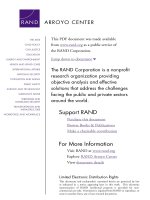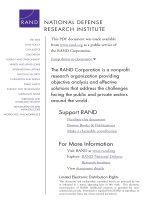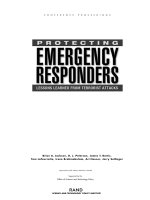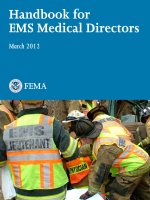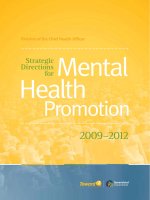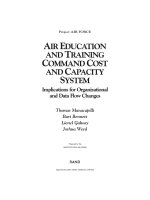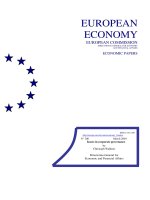SEEK IMMEDIATE HELP FOR ANY MEDICAL OR EMERGENCY CONDITION ppt
Bạn đang xem bản rút gọn của tài liệu. Xem và tải ngay bản đầy đủ của tài liệu tại đây (426.55 KB, 129 trang )
•
Please Read this Important Note
from the Publisher *
This book-on-a-
disc is a collection of official public domain U.S. federal government files. It is
designed to provide a convenient user-friendly general referenc
e work, utilizing the benefits of
the Adobe Acrobat format to uniformly present thousands of pages that can be rapidly reviewed
or printed without untold hours of tedious searching and downloading. Vast amounts of data
that might otherwise remain inaccess
ible are available for instant review. Throughout the files
on this disc, you’ll find underlined hyperlinks. Unfortunately, software limitations may prevent
some of those links from working correctly. Many are active, however, permitting rapid
navigation within the document. It is important to remember that this CD-
ROM is intended to
supplement, not replace, specific real-
time research into critical topics. With the vast array of
federal government resources available today, we cannot guarantee complete c
overage of
every topic represented on this disc.
INFORMATION ON THIS CD-
ROM IS NOT A SUBSTITUTE FOR
PROFESSIONAL MEDICAL ADVICE.
SOME OF THE INFORMATION
IN THESE DOCUMENTS IS APPLICABLE ONLY TO UNIQUE
CIRCUMSTANCES (BATTLEFI
ELD CONDITIONS, SPACEFLIGHT)
AND IS NOT INTENDED TO PROVIDE GUIDANCE FOR ROUTINE
EMERGENCIES.
IF YOU HAVE OR SUSPECT THAT YOU HAVE
ANY ILLNESS, YOU MUST CONSULT WITH A PROFESSIONAL
HEALTHCARE PROVIDER!
SEEK IMMEDIATE HELP
FOR ANY MEDICAL OR EMERGENCY CONDITION
The contents o
f the files reproduced here are solely the responsibility of the originating
government agency. Like the government, we make no claims, promises or guarantees about
the accuracy, completeness, or adequacy of the contents, and disclaim liability for errors
and
omissions. Of course, no warranty of any kind is given with respect to the contents.
Thank you!
U.S. Army Medical Research Institute of Chemical
Defense (USAMRICD)
FIELD MANAGEMENT
OF CHEMICAL CASUALTIES
HANDBOOK
Chemical Casualty Care Division
USAMRICD
MCMR-UV-ZM
3100 Ricketts Point Rd.
Aberdeen Proving Ground, MD 21010-5400
SECOND EDITION
July 2000
Disclaimer
The purpose of this Handbook is to
provide concise, supplemental reading
material for attendees of the Field
Management of Chemical Casualties
Course.
Every effort has been made to
make the information contained in this
Handbook consistent with official policy
and doctrine.
This Handbook, however, is not an
official Department of the Army
publication, nor is it official doctrine. It
should not be construed as such unless
it is supported by other documents.
Table of Contents
Introduction
1
Nerve Agents
3
Vesicants
27
Cyanide
43
Lung-Damaging Agents
48
Biological Agents
55
Field Management
79
Patient Decontamination
96
Chemical Defense Equipment
154
Appendices
184
INTRODUCTION
With the end of the Soviet Union as a global superpower, the world as
we knew it ended, and a long, drawn-out turning point in world history
began. We first witnessed this moment in 1990 with the formal reunion
of East and West Germany, through Operations Desert Shield and Desert
Storm, Operations Restore Hope in Somalia, and the United States (U.S.)
involvement in the Balkans Conflict. This historic shift will persist well
into the next century.
The ability and will to wage war on a large scale have not diminished,
only shifted to new players. Former Soviet subjects have taken new and
unpredictable directions. Strident nationalism and long suppressed ethnic
rivalries have emerged with vicious, bloody warfare the end result. The
disarray and economic upheaval inside Russia have allowed the sale of
Russian weaponry and technology to perpetuate.
The so-called third world nations have also taken advantage of the
new world order to challenge what was once thought unchallengeable.
Economic investment and economic power have given military muscle to
nations who, even ten years ago, were struggling just to feed their
people. In some cases, this newfound power has also taken on
nationalistic fervor.
As a consequence of the unprecedented world challenges, the threat
spectrum faced by the U.S. into the next century has broadened. It now
includes formerly democratic governments, members of regional
cooperation alliances, and terrorists of all persuasions. Let’s narrow our
gaze somewhat and look at examples of threats within the chemical and
biological (C/B) threat spectrum.
THE C/B THREAT SPECTRUM
The threat of C/B weapons’ use against coalition forces in Operation Desert Storm must
be seen not as a one-time occurrence, but the first of many C/B threats the U.S. military will
face. Throughout the world, nations are still attempting to, or have in fact, produced C/B
agents and means to employ them. This handbook will provide some answers and
suggestions, but you, the medical NCO, must read and research to ensure that the mission of
providing health service support to chemical casualties will be successful.
NERVE AGENTS
GA, GB, GD, GF, VX
NERVE AGENTS
Nerve agents are considered the primary agents of threat to the U.S.
military because of their high toxicity and effectiveness through multiple
routes of entry. They are absorbed through the eyes, respiratory tract, and
skin.
TOXICITY
The nerve agents are Tabun (GA), Sarin (GB), Soman (GD), GF, and
VX. Tables I and II show the toxicities of the nerve agents by inhalation
and skin exposure.
The Ct is the product of the concentration (C) of a vapor or aerosol to
which one is exposed and the time (t) to which one is exposed to that
concentration (C). The units are usually mg/m
3
for C and minutes for t.
One can be exposed to a Ct of 100 mg-min/m
3
by staying in a
concentration of 10 mg/m
3
for 10 minutes (10x10=100), 20 mg/m
3
for 5
minutes (20x5=100), or 5 mg/m
3
for 20 minutes (5x20=100). The Ct
that will cause a biological effect is constant over a range of C and t.
Thus, if a Ct of 100 mg-min/m
3
of nerve agent causes shortness of breath,
it would be a result of any combination of C and t that produces a product
of 100.
The LCt
50
is the Ct of agent vapor that will be lethal (L) to half of the
population exposed to it. The ICt
50
is the Ct that will incapacitate (I) half
of those exposed to it. The word “incapacitate” must be defined when
using this term. For example, dim vision might incapacitate a soldier for
some jobs, in which case the ICt
50
will be the Ct needed to cause dim
vision. On the other hand, incapacitation might be defined as loss of
consciousness and twitching, in which case the ICt
50
will be the Ct needed
to produce these effects. The ICt
50
shown is that causing severe effects,
including convulsions.
Table I shows the estimated LCt
50,
estimated ICt
50
, and Ct that will
cause pinpointing of the pupils (miosis) in half of the population (MCt
50
).
Units of the Cts are mg-min/m
3
. Table II shows the estimated amounts
that will cause lethality in half of the population when placed on the skin.
The LD
50
is the dose (D) of agent liquid or solid that is lethal (L) to half
of the population exposed to it. The LD
50
of VX, when placed on human
skin, is the size of a droplet that will cover the width of two columns of the
Lincoln Memorial on a Lincoln penny.
TABLE I. Vapor Toxicity
mg-min/m
3
Agent LCt
50
ICt
50
MCt
50
GA 400 300 2-3
GB 100 75 3.0
GD 70 UNK <1.0
GF UNK UNK <1.0
VX 50 35 0.04
TABLE II. LD
50
on Skin
Agent Amount
GA 1000 mg
GB 1700 mg
GD 50 mg
GF 30 mg
VX 10 mg
MECHANISM OF ACTION
When a soldier is poisoned by a nerve agent, the action of the enzyme
acetylcholinesterase is blocked. The normal function of
acetylcholinesterase is to break down or hydolyze the chemical
acetylcholine. Acetylcholine is a neurotransmitter, or messenger chemical.
Nerve paths, which are divided into sections with gaps between the nerve
endings and between the nerve ending and the target organ, are used to
pass a command from the central nervous system to various organs. These
gaps are crossed by acetylcholine, the messenger, which relays the
command on to the next step and finally to the target. Under normal
conditions, when the required action at each step is completed, the
acetylcholine is broken down by the acetylcholinesterase, thus stopping the
action. However, when a nerve agent inhibits the acetylcholinesterase, this
enzyme cannot perform its normal function of hydrolyzing the
acetylcholine. Acetylcholine then accumulates along the nerve path, and
the target organ’s action continues uncontrolled. Muscles become
hyperactive and twitch uncontrollably, and glands secrete copiously.
NERVE AGENT EFFECTS
The nerve agent’s mechanism of action is to inhibit the enzyme
acetylcholinesterase. Inhibition of this enzyme allows the neurotransmitter.
acetylcholine, to accumulate at the nerve endings where it causes
excessive stimulation of the target organ. The parts of the body that are
affected by excessive acetylcholine accumulation are as follows:
• Eyes
• Nose (glands)
• Mouth (glands)
• Respiratory tract
• Gastrointestinal tract
• Cardiac muscle
• Sweat glands
• Skeletal muscle
• Central nervous system
The primary concern of the soldier medic/combat lifesaver when
treating the nerve agent poisoned soldier is to provide correct, timely, and
lifesaving care. The first step in providing this care is to understand the
effects that a vapor or liquid nerve agent exposure has on the soldier.
Eyes. The eyes will be affected by direct contact with a nerve agent
vapor or aerosol. When the route of entry of the agent is through the
skin or by ingestion, the effect on the eyes is delayed or may not occur.
The main effect of the agent is to cause miosis, or pinpointing, of the
pupils. One or both pupils may be pinpointed and unresponsive to light or
darkness. Pinpointing causes a complaint of dim vision that is more
pronounced in low light conditions. Frontal headache, mild aching around
the eye, or severe pains are common complaints in a soldier exposed to a
moderate concentration of agent. Twitching of the eyelids may be
observed through the protective mask, and the eyes may be reddened.
When a light source is used to test for pupillary response, the soldier may
complain of an increase in aching behind the eyes due to light sensitivity.
Nose and Mouth. The secretory glands of the nose and mouth are as
sensitive or more sensitive to nerve agent vapor or aerosol than the
eyes are. When the soldier is poisoned by nerve agent liquid on the skin or
by ingestion, the nose will become affected, but only in response to the
whole body (systemic) involvement. When exposed to a nerve agent vapor
or aerosol, the nose will begin to run. This effect has been described by
patients recovering from accidental nerve agent vapor exposure as “worse
than a cold or hay fever” and “like a leaking faucet.” Even after low
concentrations of agent, rhinnorhea may be severe.
The mouth will secrete excessive amounts of saliva that may be so
copious that watery secretions run out the corners of the mouth.
Respiratory Tract. Inhalation of a small amount of nerve agent vapor
will cause the soldier to complain of tightness in the chest or shortness of
breath (dyspnea). This occurs because the excessive
acetylcholine stimulates the muscles in the airways to contract and
constrict the airways (bronchoconstriction). As the concentration
increases, breathing difficulty will become severe. One or two breaths of a
high concentration of nerve agent vapor will cause gasping and irregular
respirations within seconds to a minute or two. Cessation of breathing
(apnea) can occur within minutes after exposure to a large amount of nerve
agent, either by liquid on the skin or vapor.
Excessive bronchial and upper airway secretions caused by stimulation
of the airway glands by the excessive acetylcholine will compound
breathing difficulty. These secretions can obstruct the airway and cause
difficulty in moving air into and out of the lungs with prolonged expiration a
noticeable effect.
Gastrointestinal (GI) Tract. After exposure to a large but sublethal
concentration of vapor, the soldier will complain of nausea and may vomit.
Also, nausea and vomiting may be the first effects from liquid nerve agent
exposure on the skin. The soldier may complain of nausea followed by
vomiting, “heartburn,” and pain in his abdomen. In addition, the soldier
may belch frequently and have diarrhea or involuntary defecation and
urination. These effects usually occur within several minutes after vapor
exposure. However, after liquid agent exposure on the skin, these effects
may not begin for as long as 18 hours after exposure.
Cardiac. The heart rate can either increase or decrease after nerve
agent exposure. Generally, blood pressure will increase, but the blood
pressure can rarely be determined in a contaminated area because the
casualty and the examiner are in protective gear. The heart rate in nerve
agent poisoning will not aid the soldier medic/combat lifesaver in choosing
the care needed.
Sweat Glands. The skin is very permeable to nerve agent. When
penetration occurs after either liquid or vapor exposure, localized sweating
occurs and progressively spreads over the surrounding skin area as nerve
agent is absorbed. The likelihood that the soldier medic/combat
lifesaver will be able to observe this sweating is minimal.
Skeletal Muscles. After exposure to a moderate or large amount of
nerve agent, the soldier will complain of weakness and twitching of muscle
groups. The twitching can first be noticed at the site of a liquid droplet on
the skin. The muscles may show a rippling effect (fasciculations). As the
nerve agent effect progresses, muscles can go into a prolonged
contraction. However, instead of a prolonged contraction, the large muscle
groups may begin unsynchronized contractions that cause the arms and
legs to flail about. The hyperactivity of the muscles in these instances
leads to muscle fatigue and flaccid paralysis (limp, unable to move). Unless
the soldier medic/combat lifesaver aggressively cares for this casualty,
he/she will not survive.
Central Nervous System (CNS). In the case of a large inhalation or
liquid dose, the effects are rapid and usually fatal under battlefield
conditions. The soldier almost immediately loses consciousness, followed
seconds later by seizure activity. Several minutes later, respiration ceases.
Without immediate care, this soldier will not survive to reach Level 1
treatment.
When exposed systemically to low amounts of nerve agent, the soldier
may complain of generalized weakness.
Understanding when these effects can most occur is critical for the
soldier medic/combat lifesaver. The length of time a casualty may be in
your care is unknown. It is best to understand what may occur and when,
because being surprised by and unprepared for the reactions of a nerve
agent poisoned soldier lessens his chances for survival. Tables III and IV
show nerve agent effects, the onset time of these effects, and the required
self- and buddy-aid.
These tables show the typical time course for mild, moderate, and
severe exposures to nerve agent. When a lethal or near lethal exposure
occurs, the time to onset of symptoms and maximal severity of symptoms
may be extremely brief. If aggressive care is not given to the soldier
exposed to a lethal concentration, death can result within five minutes after
the appearance of symptoms.
TABLE III. Nerve Agent Effects
Vapor Exposure
Mild
Eyes Small pupils (miosis)
Dim vision
Headache
Nose Runny nose (rhinnorhea)
Mouth Salivation
Lungs Tightness in the chest
Time of onset: seconds to minutes after exposure
Self-aid: 1 MARK I Kit
Buddy-aid: stand by
Severe
All of the above, plus
Severe breathing difficulty or cessation of respiration
Generalized muscular twitching, weakness, or paralysis
Convulsions
Loss of consciousness
Loss of bladder, bowel control
Time of onset: seconds to minutes after exposure
Self-aid: none; soldier will be unable to help himself
Buddy-aid: three MARK I Kits and diazepam immediately
TABLE IV. Liquid on Skin
Mild/Moderate
Muscle twitching at site of exposure
Sweating at site of exposure
Nausea, vomiting
Feeling of weakness
Time of onset: 10 minutes to 18 hours after exposure
Self-aid: 1-2 MARK I Kits, depending on severity of symptoms
Buddy-aid: stand by
Severe
All of the above, plus
Breathing difficulty or cessation of breathing
Generalized muscular twitching, weakness, or paralysis
Convulsions
Loss of consciousness
Loss of bladder and bowel control
Time of onset: minutes to an hour after exposure
Self-aid: none; soldier will be unable to help himself
Buddy-aid: three MARK I Kits and diazepam immediately
TREATMENT
The most important care the casualty receives is the care given within
the first several minutes after exposure (self-aid, buddy-aid).
Immediate care, including administration of antidotes, can mean the
difference between survival and death in a soldier exposed to a nerve
agent. It is imperative that every medic/combat lifesaver understand the
effects of nerve agents, the time in which effects occur, and the correct
steps to take to save the exposed soldier.
Every soldier must know the signs and symptoms of mild and severe
nerve agent poisoning and the correct first aid in order to evaluate and
provide the appropriate self- and buddy-aid.
SELF-AID AND BUDDY-AID
Timely and correct determination of the type of agent and route of
entry causing the signs or symptoms is critical if the poisoned soldier is to
survive to reach definitive medical care. Nerve agents will, under most field
conditions, be encountered in both the vapor and liquid forms. When nerve
agents are encountered and soldiers have donned protective equipment, a
hasty self-evaluation for signs or symptoms of poisoning must be
conducted. This self-evaluation implies that soldiers know the signs and
symptoms of mild and severe nerve agent poisoning, as well as the correct
first aid.
Tables III and IV show methods of exposure, resulting signs or
symptoms, and self-aid or buddy-aid to be rendered. It must be stressed
that timely and correct first aid actions are critical to enhance the
casualty’s chances for survival.
It must be emphasized during training that, when the effects progress
to more than one organ system, the situation is moving rapidly from a mild
to a severe exposure. The buddy’s aid in determining this change becomes
critical. As the change occurs, the remaining MARK I Kits and one
diazepam autoinjector must be administered.
Self- or buddy-aid must be promptly followed by Level 1 medical care.
SOLDIER MEDIC/COMBAT LIFESAVER TREATMENT OF
NERVE AGENT POISONING
The Level 1 care provider (medic) must rapidly determine the following:
• extent of the poisoning
• what medications have been administered
• complications induced by the poisoning and/or resulting from
conventional wounds
PROTECTIVE POSTURE
DURING TREATMENT
First, protect yourself by donning MOPP Level IV.
CASUALTY DECONTAMINATION
Next, assist the casualty in performing decontamination of exposed
skin in the following order:
• face
• neck area
• chest area
• abdomen
• arms and hands
• other exposed skin areas
Performing this decontamination eliminates nerve agents on the
skin surface that could continue to absorb into the skin causing a “time
release” effect of symptoms.
TREATMENT GUIDELINES
The treatment guidelines provided below assume that the soldier
medic/combat lifesaver is certain that nerve agent poisoning has occurred.
Use of atropine in the absence of nerve agent will cause the casualty to
experience sweat inhibition and heat storage problems in a warm climate.
DRUG THERAPY
Atropine is the drug of choice for treating nerve agent poisoning. It
will dry secretions, (including those in the airways), reduce
bronchoconstriction, and decrease gastrointestinal motility.
Atropine will not relieve miosis and will not relieve muscle twitching or
spasms.
Mild and Improving Symptoms
Observation is all that is needed for the casualty with mild symptoms
such as rhinorrhea, slight or recovering breathing difficulty, or excessive
salivation that is decreasing. In the casualty with mild symptoms that
appear to be clearing, the one MARK I Kit administered during self-aid,
followed by observation for several hours, will normally be all that is
needed.
Pain in the eyes, twitching of the eyelids, redness, and miosis cannot
be treated in the field setting by the soldier medic/combat lifesaver.
However, at the battalion aid station (BAS), eye pain can be controlled with
atropine eye drops. These conditions, although annoying, are not life
threatening.
Severe Symptoms
If the casualty has severe symptoms involving two or more major organ
systems (systemic) (gastrointestinal, skeletal muscle, respiratory, etc.), the
first step is to administer all three MARK I Kits and diazepam. Diazepam
should always be administered when the three MARK I Kits are given
together. Additionally, more atropine (2 mg, Atropen) should be given
every five minutes until secretions decrease or the casualty is
breathing easier (or it is easier to ventilate him). A total of 15 to 20 mg of
atropine may be required in the first 3 hours after the onset of symptoms.
Atropine. If the casualty is unconscious and in respiratory difficulty,
three MARK I Kits and diazepam should be given immediately, followed by
additional atropine as described above. Over the next 5 to 15 minutes, 10
to 15 mg of atropine may be needed. Atropine administered with the
autoinjector will show some effectiveness in three to five minutes. During
the time the atropine takes to reach maximum effect, the constriction and
secretions in the airway and feeling of “tightness in the chest” will begin to
decrease. Atropine will have a drying effect on salivation and rhinnorhea.
Atropine (2 mg) should be administered at three to five-minute intervals
until the casualty can tell the soldier medic/combat lifesaver that it is easier
to breathe or manual ventilation becomes easier. Observe the casualty for
indications that the atropine can be discontinued.
Discontinue atropine when:
• Secretions of the mouth, nose, and lungs are minimized.
• The casualty tells you that breathing is easier, or it is easier to
administer assisted ventilation.
Pralidoxime Chloride (2-PAMCl) in the autoinjector (600 mg, 2 ml) is
the second drug for use in nerve agent poisoning cases. The 2-PAMCl
removes nerve agent from the enzyme acetylcholinesterase. The 2-PAMCl
(included in the MARK I Kit) must be used as early as possible. If
symptoms are severe, involving two or more organ systems (for example,
the lungs and gastrointestinal tract), all three MARK I Kits and
diazepam should be given immediately. Additional 2-PAMCl autoinjectors
are not administered until an hour later. If severe signs or symptoms still
persist one hour after using the three MARK I Kits, three additional 2-
PAMCl autoinjectors should be administered. More than two sets of three
2-PAMCl (six total) must not be used. Excess 2-PAMCl may harm the
casualty by dangerously raising the blood pressure.
Discontinue the use of 2-PAMCl after symptoms of respiratory distress
have eased.
Diazepam in the 10-mg autoinjector is the drug adopted by the U.S.
military for use in controlling convulsing patients. The doctrine for its use
instructs the soldier to administer one diazepam autoinjector to his buddy
immediately after using the third MARK I Kit in severe poisoning cases.
Diazepam is not for self-use. It should be given only to severe casualties,
and severe casualties cannot self-administer it. The key to increasing the
effectiveness of the diazepam is administering it before convulsions begin.
Again, when two or more organ systems become involved, one diazepam
autoinjector should be administered along with the three MARK I Kits to
lessen the convulsive activity the soldier may experience.
The soldier medic/combat lifesaver may administer a second and third
diazepam autoinjector using the guidelines below.
After the first injection (buddy-aid):
• Observe the casualty for about ten minutes.
• Turn the casualty on his/her side to facilitate breathing.
• Pad areas to prevent other injuries.
• Restrain if necessary.
• If still convulsing after ten minutes, give the second
diazepam autoinjector.
Following the second injection (medical aid):
• Observe the casualty for five to ten minutes.
• If still convulsing after five to ten minutes, give a third
diazepam autoinjector.
VENTILATION
Although the use of pyridostigmine pretreatment will decrease the need
for assisted ventilation in nerve agent casualties, the need will arise, on
occasion, for assisted ventilation in some severe nerve agent casualties.
Aggressive airway maintenance and the use of assisted ventilation will
greatly increase the casualty’s chances for survival.
Providing assisted ventilation in a potentially contaminated environment
is possible using the Resuscitation Device Individual Chemical (RDIC) (see
chapter on equipment). By using this device, the soldier can survive to
reach the Level 1 care facility where mechanical ventilation can take over.
Without this aggressive, far-forward resuscitation, the soldier will not
survive.
PRETREATMENT
The U.S. military has adopted the policy of pretreating soldiers against
the nerve agent’s effect on acetylcholinesterase with pyridostigmine. Each
soldier in the combat theater of operations is issued one package of
pyridostigmine tablets. Each blister pack contains 21 tablets, and each
tablet contains 30 mg of pyridostigmine. The soldier takes the
pretreatment only on order from the unit commander. When ordered, one
tablet is taken orally every eight hours. If a scheduled dose is missed, it
will not be made up; the soldier will take one tablet at the earliest
opportunity to begin the next eight-hour interval. The soldier will
discontinue taking the tablets on order from the unit commander. The
pretreatment should not be taken on a continuous basis for longer than 14
days.
Pyridostigmine bromide shields the acetylcholinesterase enzyme from
the full effects of GD. It prevents GD from permanently and irreversibly
binding the enzyme, which it would otherwise do in two minutes.
Pyridostigmine enhances the efficacy of 2-PAMCl in GD casualties. The
pretreatment does not increase the effectiveness of treatment for GB, GF,
or VX. These nerve agents also become irreversibly bound to
acetylcholinesterase but require many hours to do so, and the binding does
not affect therapy.
Pretreatment alone will not protect the soldier and does not reduce the effects from
the nerve agent. Pretreatment is not an antidote. When used in conjunction with the
MARK I Kit, pyridostigmine enhances the effectiveness of the MARK I Kit against
GD only. It is critical that the soldier medic understand that the effect of the
pretreatment will have no effect on the severity of nerve agent poisoning symptoms.
Therefore, an aggressive approach to care is still warranted.
MUSTARD
HD, L
VESICANTS
The blister agents are second only to nerve agents as a concern to the
U.S. military. The primary threat blister agents are sulfur mustard (H/HD),
Lewisite (L), and a mixture of mustard and Lewisite (HL).
Mustard is a concern because there are large stockpiles of it, it is
easily manufactured, and because it is both incapacitating and lethal.
Mustard was the largest cause of chemical casualties in World War I. It
was also used extensively by Iraq in the war with Iran. Although there
were many casualties from mustard in World War I, only about 3% of the
casualties died as a result. This low death rate occurred despite the
relatively poor protection and level of medical care available at that time
(e.g., no antibiotics).
Mustard rapidly penetrates the skin causing both localized cellular
damage and systemic damage. The true deadly nature of the agent’s
effect is that the soldier exposed to a large amount of liquid or vapor
mustard faces total systemic assault. The reasons for this are (1) failure
of the body’s immune system, with sepsis and infection as the major
contributing causes of death, and (2) pulmonary damage, which is also a
major contributory factor in death.
PHYSICAL CHARACTERISTICS
The severity of blister agent effects will, in part, be affected by the
environmental conditions at the time of exposure. Warm, humid
conditions increase the severity of blister agent damage and shorten the
time of symptom onset. Cold weather retards the time of symptom onset,
and providing the exposed skin remains cold, lessens the severity of blister
agent damage.
Mustard (H/HD) has a fairly high freezing point of 58
o
F agent, while
the mixture HL, containing 37% HD to 63% Lewisite, has a freezing point
of –13
o
F. The lower freezing point of the mixture will cause the agents to
have a significant impact on combat operations in a cold northern
environment, as well as in a warm desert environment.
Blister agents also have a relatively high vapor density when
compared to air. Mustard has a vapor density 5.4 times greater than air,
Lewisite a density 7.1 times greater, and HL is 6.5 times heavier than air.
The more dense a vapor is, the more likely it is to flow to low spots such
as valleys, closed spaces, or the floor.
The soldier medic/combat lifesaver can use the current intelligence on
threat chemical capabilities and the physical characteristics of
blister agents to determine likely exposure mechanisms (liquid and/or
vapor) based on temperature. Utilizing all of these data elements, the
combat lifesaver and combat medic can then be proactive to the predicted
chemical threat; that is, take active steps to prevent or lessen the impact
of chemical agent employment on individuals. This information, coupled
with understanding the medical implications of an exposure, will allow the
combat lifesaver/soldier medic to “wargame” scenarios and anticipate,
ahead of time, the required, correct response needed to optimize casualty
care.
When operating in cold northern climates or desert regions,
particularly at night, care must be exercised to prevent getting
contamination into warm-up tents, operations areas, or sleeping areas. An
agent at its freezing temperature brought in on clothing or skin will liquefy
as it warms and slowly produce vapors. Unless this situation is detected
early, soldiers will be exposed within these confined spaces. In the
temperature ranges mentioned earlier, provisions must be made for
monitoring personnel and their equipment in a warm-up tent before the
individuals occupy work or rest areas. All personnel in the monitoring tent
must wear protective masks during monitoring.
If the unit fails to conduct monitoring of personnel and equipment
before entering sleep or work areas, the potential exists for intoxication by
multiple routes of exposure. Soldiers could absorb agent through the
skin by handling equipment contaminated with a liquid agent, or vapors
desorbing from equipment contaminated by liquid agent could affect the
eyes and respiratory tract.
DETECTION
Mustard received its name because of its garlic, horseradish, or
mustard odor and can be detected by smell, visual observation, M8 and
M9 Chemical Detection Papers, the M256A1 Chemical Detection Kit, and
the CAM.
The human nose can detect mustard (H/HD) in concentrations of 0.6
to 1.0 mg/m
3
. While this seems an undesirable way to detect
blister agent, it must be understood that the U.S. military has no
automatic vapor/liquid detection capability. Alert soldiers will most likely
smell the agent vapor before encountering the liquid.
After release, H/HD appears as a thick, colorless or pale yellow liquid,
and HL appears as a dark oily liquid.
The M8 Chemical Detection Paper will turn red in the presence of
liquid mustard. The detector ticket from the M256A1 will detect mustard
vapor in concentrations of 2 mg/m
3
to 12 mg/m
3
within 10 minutes. The
CAM will detect mustard in concentrations of 0.03 mg/m
3
to 30 mg/m
3
.
EFFECTS
H/HD. Clinical signs and symptoms from mustard exposure are not
apparent until hours later (see Table); however, tissue damage occurs
within two minutes. If decontamination is not done within the first two
minutes after exposure, nothing can be done to prevent a mustard injury.
Clinical effects occur on the skin, in the eyes, and in the airways. In
the event of severe exposure, effects occur days later in the bone marrow
and gastrointestinal tract.
The effects on the skin are redness (erythema) that resembles
sunburn, and later, blisters. The eyes initially are irritated and later may
become swollen shut. The first effects in the airways are the upper
airways, with a hacking cough, hoarseness, and throat and nasal
irritation. If the exposure is severe, the agent later damages the lower
airways.
The major effects and the times at which the first effects begin are
shown in the table.
HL. The effect of HL liquid on the eyes and skin, or vapor in the eyes
or respiratory tract, is immediate. HL causes intense pain and lid
twitching in the eyes. Within an hour, edema of the conjunctivae and lids
begins and rapidly results in eye closure.
The casualty feels stinging pain within seconds after contact with
liquid HL. The pain causes the casualty to decontaminate rapidly. Rapid
decontamination is the only way to avoid severe burns. After five minutes
of contact with HL, the upper layer of skin (epithelium) will die and appear
gray. Painful erythema will begin shortly afterwards, and painful blisters
may appear within 12 hours.
The immediate irritation from HL vapor is so intense that an individual
will immediately mask or exit the area. Respiratory casualties will be
unable to do either. Pulmonary effects are similar to those caused by
mustard alone, except that pulmonary edema (fluid in the lungs) is more
likely after Lewisite.
SELF-AID AND BUDDY-AID
The actions needed for self-aid or buddy-aid are essentially
nonmedical in nature. Reacting as quickly as possible to warnings of an
attack by donning the protective mask and going to MOPP IV, detecting
the agent as early as possible, and removing any suspect liquid
(decontaminating) using the M291 Skin Decontaminating Kit (SDK) are the
easiest ways to prevent a blister agent casualty. Reacting quickly to
attack indicators will prevent most, if not all, casualty-causing exposures.
Some indicators that an attack is in progress or you have come in contact
with agent from a previously unknown attack are as follows:
• The out of place smell of mustard, garlic, or onion.
• Color change in M9 detector tape.
• Overt indications such as enemy helicopters spraying liquid, indirect
artillery fire which detonates with dull or muffled explosions.
• An oily feeling of “rain” as it impacts on exposed skin.
• Liquids that appear too thick or oily and appear out of place on
equipment, plants, or terrain.
Self-aid or buddy-aid for exposure to blister agents includes
decontamination of the eyes. When exposure is suspected, time is
critical. Unless the individual was wearing a protective mask at the time
of the suspected exposure, the assumption must be that the eyes were
exposed. Following the task in STP 21-1-SMCT, Soldier’s Manual of
Common Tasks, the individual must decontaminate the eyes and, although
this is not a buddy-aid task, having assistance will increase the
effectiveness of the procedure. Remember that time is critical for
effective mustard decontamination because blister agents become “fixed”
to tissue components within two minutes after deposition. Using the
M291 SDK as soon as possible to remove agent and flushing the eyes
with water will do much to prevent or lessen the physical damage from
blister agent exposure.
TABLE. Effects of Mustard Vapor
ORGAN SEVERITY EFFECTS ONSET
Eye Mild Tearing
Itchy
Burning
Gritty feeling
4-12
hours
Moderate Above, plus
Reddening
Swelling of lids
Moderate pain
3-6
hours
Severe Marked swelling of
lids
Possible cornea
damage
Severe pain
1-2
hours
Airways Mild Runny nose
Sneezing
Nosebleed
Hoarseness
Hacking cough
12-24
hours
Severe Above, plus
Severe productive
cough
Shortness of breath
(mild to severe)
2-4
hours
Skin
Erythema (redness)
Blisters
2-24
hours
COMBAT LIFESAVER/MEDIC ACTIONS
The initial medical treatment actions required by the combat
lifesaver/soldier medic at the time of exposure is little more than what the
individual himself can do. Self-aid decontamination must be done at the
time of exposure. Because of the long time delay until the onset of
symptoms under combat conditions, the wounded, exposed individual will
have been returned to duty or evacuated by the time symptoms appear.
CASUALTY DECONTAMINATION
The casualty should have performed skin and equipment
decontamination with the M291 and the M295 before being seen by the
combat lifesaver/soldier medic. Because of the persistent nature of
blister agents, the decontamination of the patient must be as thorough as
possible. As with nerve agent exposure, you must protect yourself by
masking and donning MOPP gear. When beginning treatment, attempt to
determine what type of decontamination has been done and when.
Understanding the potential contamination threat posed by the casualty
will allow the combat lifesaver/soldier medic to avoid cross contamination.
FIELD TREATMENT
The actions required at the unit level for blister agent casualties are
two-fold. First is triage for evacuation or return to duty, and second is the
actual treatment of the casualty. Triaging the soldier is based on several
factors – the severity of observable effects, the opinion of the triaging
combat lifesaver/soldier medic as to whether or not the effects will
progress further, and the impairment of normal duty requirements the
symptoms cause in the individual.
Casualties with signs or symptoms that appear at the earliest onset
time possible (see Table) generally require evacuation with little chance for
quick return to duty from the Medical Treatment Facility (MTF) because
the initial effects will progress. Faster onset of symptoms can indicate
exposure to higher concentrations of agent with more severe lesions, for
which the care available at a MTF is required.
Eyes. Individuals with mustard conjunctivitis will require application
of a steroid antibiotic eye ointment. FM 8-285, Treatment of Chemical
Agent Casualties and Conventional Military Chemical Injuries, recommends
dexamethasone sodium phosphate-neomycin ophthalmic ointment for
application. This drug decreases the inflammation and has antibacterial
effects. Systemic narcotic analgesics are recommended for eye pain.
Under no circumstances should the eyes be bandaged as this will allow
the eyelids to stick together, and the secretions will not have a means to
drain. The resulting accumulation in the conjunctival sac can lead to
infection and corneal ulcerations. Individuals presenting with blister agent
conjunctivitis will require evacuation to a MTF for treatment by an
ophthalmologist as soon as possible.
Skin. Individuals presenting with erythema (reddening of the skin)
